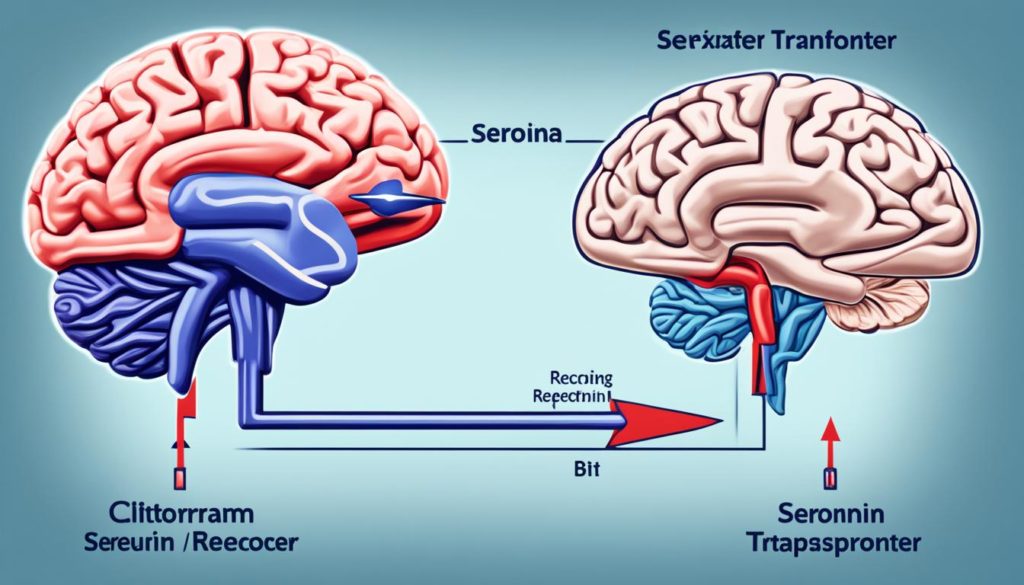Welcome to your complete antidepressant guide on Citalopram, also known as Celexa. This medication is key in treating depression and anxiety. It’s a vital part of modern mental health care. We’ll cover how it works, its benefits, how much to take, side effects, and how it interacts with other drugs. This knowledge helps you make better choices for your mental health.
Key Takeaways
- Citalopram, known as Celexa, is a common SSRI for depression and anxiety.
- This guide explains its action, benefits, dosage, and side effects.
- Knowing how SSRIs work is key for good mental health care.
- We discuss managing side effects and drug interactions.
- There are alternatives to Citalopram and tips for successful treatment.
Introduction to Citalopram (Celexa)
Citalopram, also known as Celexa, is a common medication for mental health issues. The FDA has approved it as a treatment for depression. It’s part of the SSRI drug class. This type of drug helps by changing the levels of serotonin in the brain.

What is Citalopram?
Citalopram is a key SSRI drug. It boosts serotonin levels, which helps with mood, feelings, and sleep. This makes it a key part of antidepressant treatment. It’s mainly used for major depressive disorder (MDD), helping people feel better.
Overview of Celexa
Celexa is the brand name for Citalopram. It was created by Lundbeck, a Danish company. Celexa became popular for treating depression with fewer side effects. It gave doctors a reliable option for their patients.
Citalopram as an Antidepressant
Citalopram is a strong antidepressant in psychiatric care. It helps keep mood stable, making it a key part of treatment plans. Studies show it’s a top choice for managing depression through antidepressants.
How Citalopram (Celexa) Works
Learning how Citalopram works can help us understand its importance in treating mental health issues. We’ll look into its action and the part SSRIs play in mental health.
Mechanism of Action
The main way Citalopram works is by stopping serotonin from being taken back by the brain. It does this by blocking the serotonin transporter. This lets more serotonin stay in the space between brain cells, improving how well brain signals work.
This boost in serotonin helps reduce depression symptoms. It also makes mood and emotional health better.
Role of SSRIs in Mental Health
Citalopram is an SSRI, a type of drug that targets serotonin levels in the brain. SSRIs like Celexa are key in treating mental health issues by fixing serotonin imbalances seen in depression and anxiety. Studies have proven that SSRIs work well in easing depression and boosting mental health.

Benefits of Using Citalopram
Citalopram (Celexa) helps people feel better when they’re down or anxious. Studies and real-life stories show it makes a big difference in how people live.
Effectiveness in Treating Depression
Citalopram benefits include being a strong treatment for depression. Many studies prove it helps lessen sad feelings. It gives hope to those fighting depression.
Anxiety Relief
Citalopram also helps with anxiety. People with anxiety see their worries go down. It tackles both depression and anxiety, making life better for many.
Improvement in Quality of Life
Citalopram does more than just ease anxiety and depression. It helps people live better lives. They can do more, keep up with friends, and reach their goals. Doctors say it makes life more balanced and rewarding for those with mental health issues.
| Benefit | Clinical Outcome |
|---|---|
| Effectiveness in Treating Depression | Significant reduction in depressive symptoms, high success rate |
| Anxiety Relief | Marked decrease in symptoms of anxiety disorders |
| Improvement in Quality of Life | Enhanced daily functioning, better relationships, personal and professional achievements |
Dosage and Administration
Finding the right citalopram dosage and knowing how to take Celexa is key. Following SSRI dosing guidelines helps manage symptoms well and reduces side effects.
Recommended Dosages
Adults usually start with 20 mg of citalopram daily. This can go up to 40 mg if needed. Elderly patients often start with 10 mg to avoid too strong effects.
How to Take Celexa Safely
Take Celexa at the same time every day, with or without food. It’s best to stand up slowly to avoid dizziness. Sticking to the schedule helps the medicine work better.
Adjustments for Special Populations
People with liver or kidney problems need lower doses and slower increases. Pregnant or breastfeeding women should talk to their doctor. They might need special care.
| Population | Starting Dose | Maximum Dose |
|---|---|---|
| Adults (General) | 20 mg/day | 40 mg/day |
| Elderly | 10 mg/day | 20 mg/day |
| Liver Impairment | 10 mg/day | 20 mg/day |
| Kidney Impairment | 10 mg/day | 20 mg/day |
| Pregnant/Breastfeeding Women | Consult provider | Consult provider |
Potential Side Effects of Citalopram
Understanding the side effects of antidepressants like Citalopram is key for safety. Citalopram can help many people, but knowing the Citalopram side effects is important. Spotting these early can help lessen their impact.
Common Side Effects
Citalopram is usually easy to take, but some may notice side effects. These can include:
- Nausea
- Dry mouth
- Drowsiness
- Increased sweating
- Tremors
- Diarrhea
How often and how bad these side effects are can vary. They often go away as your body gets used to the medicine.
Severe Side Effects and When to Seek Help
Even though rare, serious SSRI adverse effects with Citalopram are important to watch for. If you have severe side effects, get medical help right away. Look out for these signs:
- Severe allergic reactions, such as rash, itching, or swelling
- Chest pain or palpitations
- Seizures
- Suicidal thoughts
- Unusual bleeding or bruising
It’s key to quickly address severe reactions for depression medication safety. If you see any of these symptoms, talk to a healthcare provider right away.
Knowing about SSRI adverse effects and watching your health closely can make treatment with Citalopram safer and more effective.
Managing Side Effects
Dealing with side effects of medications like Citalopram requires a proactive approach. Effective management ensures you get the most from your treatment while keeping your quality of life high. Here are some expert tips and advice to help manage Citalopram side effects:
- Monitor and Document Side Effects: Keep a daily log of any SSRI side effects you experience. This can help in identifying patterns and providing detailed information to your healthcare provider.
- Stay Hydrated and Eat Well: Hydration and a balanced diet can play crucial roles in mitigating side effects. Proper nutrition supports overall health and boosts the body’s resilience.
- Regular Exercise: Engage in regular physical activity to alleviate some common SSRI side effects such as fatigue and body aches. Exercise also promotes mental well-being.
If you experience severe or persistent side effects, it’s important to discuss this with your healthcare provider. They may adjust your dosage or recommend other antidepressant care options to better suit your needs.
Communicate Openly: Always communicate openly with your healthcare provider about any side effects experienced. Clear and honest communication will aid in effective side effects management. It’s also crucial to never stop taking Citalopram abruptly without professional advice.
Citalopram for Anxiety Disorders
Citalopram, also known as Celexa, is a widely used treatment for anxiety disorders. Many studies show it helps people with anxiety feel better. It offers relief to those who are struggling.
Effectiveness in Anxiety Relief
Celexa has been proven to reduce anxiety symptoms in clinical trials. People taking it often notice a big drop in their anxiety. This leads to a better life overall.
- Reduction in panic attacks
- Enhanced social interactions
- Better sleep quality
Patients often say their anxiety symptoms decrease a lot. This means they can do more and enjoy life more.
Comparisons with Other Treatments
It’s important to compare Celexa with other treatments for anxiety. Citalopram stands out for its effectiveness and fewer side effects. It covers a wide range of anxiety symptoms.
| Medication | Effectiveness | Side Effects |
|---|---|---|
| Citalopram (Celexa) | High | Mild to moderate |
| Sertraline (Zoloft) | Moderate | Moderate |
| Fluoxetine (Prozac) | Moderate | Mild to moderate |
From these comparisons, Celexa seems like a strong choice for anxiety. But, the right treatment depends on your health and needs. Always talk to a doctor to find the best option for you.
Interactions with Other Medications
Understanding Citalopram drug interactions is key for medication safety and the best treatment results. Mixing Citalopram (Celexa) with other drugs can sometimes be risky or reduce its effectiveness. We’ll look at common drug interactions and how to handle them safely.
Common Drug Interactions
Some common Celexa combination therapy interactions include other antidepressants, pain relievers, and blood thinners. For example, taking Citalopram with SSRIs or SNRIs can raise serotonin levels too high, causing serotonin syndrome. Also, NSAIDs may increase the chance of bleeding when used with Citalopram.
Another interaction is with anticoagulants like warfarin, which can raise the risk of bleeding. Medications like cimetidine, used for stomach issues, can also change how Citalopram works and might need dosage changes. Always talk to your healthcare provider about these Citalopram drug interactions.
Safety Precautions
When thinking about Celexa combination therapy, safety first is crucial. Tell your healthcare provider about all the medicines you’re taking, including over-the-counter items and supplements. This helps avoid problems. Regular check-ups and monitoring are key for medication safety.
To stay safe, remember:
- Avoid using multiple SSRIs at once.
- Watch for signs of serotonin syndrome, like feeling agitated or having muscle stiffness.
- Talk to your healthcare provider before changing your meds.
By taking these steps, you can manage Citalopram drug interactions safely and make sure your treatment works well.
Alternatives to Citalopram
If you can’t handle the side effects of Citalopram, there are other options for treating depression and anxiety. Knowing about Citalopram alternatives helps in making a smart choice.
Other SSRIs
SSRIs are a top choice for fighting depression. Some popular SSRI options include:
- Fluoxetine (Prozac)
- Sertraline (Zoloft)
- Paroxetine (Paxil)
- Escitalopram (Lexapro)
Each drug has its own set of benefits and side effects. For example, Fluoxetine can boost energy, making it great for those feeling very tired. You can learn more about these drugs at this link.
Here’s a comparison of some common SSRIs to help pick the best SSRI options:
| Medication | Common Benefits | Potential Side Effects |
|---|---|---|
| Fluoxetine (Prozac) | Increased energy, long half-life | Insomnia, anxiety |
| Sertraline (Zoloft) | Effective for PTSD, anxiety disorders | Diarrhea, sexual dysfunction |
| Paroxetine (Paxil) | Strong anxiety relief, sedative effects | Weight gain, withdrawal symptoms |
| Escitalopram (Lexapro) | Well-tolerated, fewer drug interactions | Headaches, nausea |
Non-SSRI Antidepressants
For those looking beyond SSRIs, non-SSRI antidepressants are an option. These drugs work differently, offering more choices for treatment.
- Venlafaxine (Effexor) – a Serotonin-Norepinephrine Reuptake Inhibitor (SNRI)
- Bupropion (Wellbutrin) – a Norepinephrine-Dopamine Reuptake Inhibitor (NDRI)
- Mirtazapine (Remeron) – a Noradrenergic and Specific Serotonergic Antidepressant (NaSSA)
Non-SSRI antidepressants are great when SSRIs don’t work or for specific symptoms like fatigue or weight gain. Venlafaxine is good for depression and anxiety. Bupropion helps with smoking cessation and has fewer sexual side effects. Learn more about these drugs and their benefits.
Tips for Success with Citalopram Treatment
To succeed with Citalopram treatment, you must stick to the plan and add other therapies for the best results. This approach can greatly improve how well your treatment works.
Adherence to Treatment Plan
It’s key to follow your medication adherence closely for Citalopram treatment to work well. Listening to your doctor’s advice helps keep your mood stable and symptoms down. It also helps prevent coming back to old problems. Studies prove that sticking to your treatment plan leads to better results. For more tips, check out this advice.
Combining Medication with Therapy
Mixing medication with therapy often gives the best outcomes. This method helps with both the mind and body. Therapy like cognitive-behavioral therapy (CBT) works well with Citalopram, tackling deep issues and supporting long-term mental health. Using a full approach helps patients get the most from their treatment and feel better overall.
Conclusion
This Citalopram guide shows how Citalopram (Celexa) helps people with depression and anxiety. It’s important to know how it works and its benefits and side effects. This knowledge can make a big difference in how well the treatment works.
It’s key to talk openly with your doctor to get the best treatment plan. If you have side effects, talk about them. Sometimes, changing to another type of antidepressant can help meet your mental health goals. Adding therapy to your treatment can also make a big difference.
This guide aims to give you the info you need to make smart choices about your mental health care. If you’re starting or changing your treatment, knowing about Citalopram is vital. Always talk to your doctor for advice that fits your needs. With the right info and support, you can find your way to better mental health.
FAQ
What is Citalopram used for?
Citalopram, known as Celexa, is mainly used to treat depression. It’s an SSRI that boosts serotonin in the brain. This can help improve mood and lessen depression symptoms.
How does Citalopram (Celexa) work?
Citalopram stops the brain from reabsorbing serotonin. This means more serotonin is available, which helps with mood and reduces depression and anxiety. It’s part of the SSRI class, often used for mental health.
What are the potential side effects of Citalopram?
Side effects of Citalopram include nausea, dry mouth, feeling sleepy, sweating more, and being tired. Serious side effects like heart rhythm changes, serotonin syndrome, or severe allergic reactions are rare but possible. Always talk to a healthcare provider if you have severe symptoms.
How should I take Celexa safely?
Take Celexa exactly as your doctor says, usually once a day, with or without food. It’s important to follow the dosage schedule and not skip doses. Stopping the medication without advice can cause withdrawal symptoms.
Can Celexa be used for anxiety relief?
Yes, Celexa is sometimes used for anxiety because it can help with anxiety symptoms. Studies show SSRIs like Celexa can treat anxiety disorders, including GAD, social anxiety, and panic disorder.
What are the recommended dosages for Citalopram?
The starting dose for Citalopram is 20 mg daily for depression. Your doctor may adjust this based on how you respond. The highest dose is usually 40 mg daily. Elderly patients or those with liver issues might need different dosages.
What are common drug interactions with Citalopram?
Citalopram can interact with other drugs, like MAO inhibitors, other SSRIs, blood thinners, NSAIDs, and some supplements. These interactions can lead to serotonin syndrome, bleeding, or other issues. Always tell your doctor about all the medications you’re taking.
Are there alternatives to Citalopram for treating depression?
Yes, there are other antidepressants like sertraline (Zoloft) and fluoxetine (Prozac). Non-SSRI options include bupropion (Wellbutrin) and venlafaxine (Effexor). Your doctor can help pick the best treatment for you based on your health history.
How can I manage side effects from Citalopram?
To manage side effects, stay hydrated, eat well, and exercise regularly. Talk to your healthcare provider about any side effects that bother you. They can help adjust your treatment plan if needed.
What should I do if I miss a dose of Citalopram?
If you miss a dose, take it as soon as you remember, unless it’s almost time for your next dose. Don’t take extra doses. Sticking to your schedule helps avoid missing doses.


